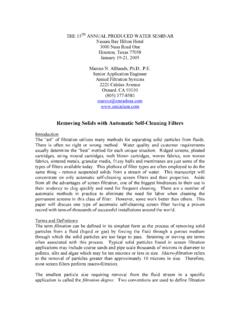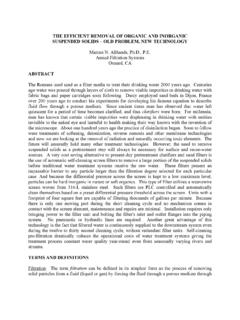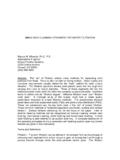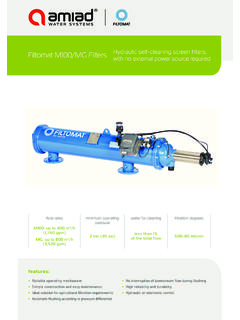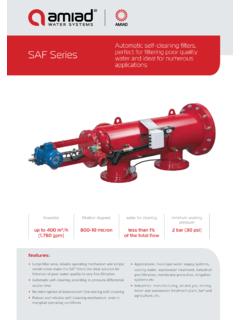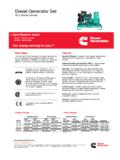Transcription of AMIAD SELF-CLEANING STRAINERS FOR WATER …
1 AMIAD SELF-CLEANING STRAINERS FOR WATER filtration . Marcus N. Allhands, , Applications Engineer AMIAD filtration Systems 2220 Celsius Avenue Oxnard, CA 93030. (800) 969-4955. Abstract: The art of filtration utilizes many methods for separating solid particles from fluids. There is often no right or wrong method. WATER quality and customer requirements usually determine the best method for each unique situation. The filtration spectrum divides solid particle sizes into five segments ranging from ions to macro particles. Three of these segments fall into the dissolved solids realm while the other two comprise suspended solids.
2 Important terms to define include filtration degree , effective filtration area and filtration open area. A thorough study of this subject must look at WATER quality parameters important to proper filtration methods. The predominant physical parameters are total suspended solids (TSS) and particle size distribution (PSD). These two parameters are the key tools used in the art of screen filtration . Three common methods of fluid/solid separation are kinetic, surface and contact filtration . Surface filtration (straining) will be the focus of this paper. Filter or strainer cleaning methods can be categorized as manual cleaning , simple back flushing, mechanical cleaning , direct flushing and forced back flushing.
3 Forced back flushing is also referred to as suction scanning. A complete description of the operating principles of a fully automatic SELF-CLEANING suction scanning screen strainer are given in this manuscript. Terms and Definitions filtration : The term filtration can be defined in its simplest form as the process of removing solid particles from a fluid (liquid or gas) by forcing the fluid through a porous medium through which the solid particles cannot pass. The filtration spectrum divides solid particle sizes into five segments ranging from sub- molecular ions to macro particles.
4 See Table 1 for examples of each range. RANGE SIZE EXAMPLES. Ionic < micron Ca+, Cl-, Fe++, Na+. Molecular - micron Sugar, Virus, Gelatin Macro-Molecular 1 micron Tobacco Smoke, Bacteria Micro-Particular 1 10 micron Red Blood Cells, Flour Macro-Particular 10 3500 micron Pollen, Beach Sand Table 1: filtration Spectrum filtration Degree: The smallest particle size requiring removal from the fluid stream in a specific application is called the filtration degree. Two conventions are used to define filtration degree. One is taken from the textile industry referring to the density of threads expressed as the number of threads per linear inch.
5 This definition uses the term "mesh" to describe the filtration degree. In the field of filtration the term has come to mean the number of pores or openings per linear inch in a woven media. Although still in common use, the term "mesh" is not a true parameter of measurement since the actual opening or pore size of such a medium depends on the diameter of the threads or wires and the type of weave used in the manufacturing process. The second convention used to describe nominal filtration degree, preferred in the industrial arena, is an actual linear dimension of the shortest distance (length or width) across an individual opening or pore of the filter medium.
6 This is most often given in microns; 1/1000 of a millimeter or of an inch. The absolute filtration degree is the length of the longest straight line distance across an individual opening of the filter medium. Effective filtration Area: The total area of the filter medium that is exposed to fluid flow and is usable for the filtration process is referred to as the effective filtration area. Any structural member or other solid barrier that prevents fluid flow and particle separation from occurring over any surface area of the filter medium, such as structural supports, is not included in the effective filtration area.
7 filtration Open Area: Another important definition needed when comparing filters and filtration methods is the filtration open area. This is the pore area or sum of all the areas of all the holes in the filter medium through which the fluid can pass. filtration open area is often expressed as a percentage of the effective filtration area. The type of filter medium can affect this greatly as shown in Table 2. filtration OPEN AREA. filtration DEGREE WEAVE WIRE WEDGE WIRE. 500 micron 43% 33%. 200 micron 37% 100 micron 32% Table 2: filtration Open Area WATER Quality WATER quality consists of a multitude of parameters, some relevant to filtration and many of no consequence.
8 These parameters can be divided into two basic aspects, chemical and physical. Of primary concern in the filtration process are certain physical parameters with a few chemical parameters as possible secondary concerns. Total Suspended Solids (TSS): Particle load or total suspended solids (TSS) is of major concern in filtration and is best defined as the concentration of total solid particles above the molecular range given in milligrams per liter (mg/L) or parts per million (ppm). This alone offers limited help in the design of filtration systems. Particle Size Distribution (PSD): If along with TSS the particle size distribution (PSD) is known, the concentration (or volume) of particles removed from the fluid by a filter is readily determined for a given filtration degree.
9 PSD is given in particle counts (particle density) per size unit, usually in one-micron increments. PSD can also be given in percent volume of TSS (volume density) per size unit. The latter means of expressing PSD is much more useful in designing macro filtration systems. Additional WATER Quality Factors: Table 3 shows secondary WATER quality factors that may or may not affect the filtration process. BOD Biochemical Oxygen Demand VSS Volatile Suspended Solids TDS Total Dissolved Solids pH Acidity/Alkalinity Hardness Calcium/Magnesium Turbidity Measurement of light scattered through a WATER sample Table 3: Secondary WATER Quality Factors Clogging Factors Those elements that cause a filter or strainer to loose hydraulic capacity are referred to as clogging factors and can be divided into organic and inorganic segments.
10 Organic clogging factors include all phyto-plankton such as algae and some bacteria, zooplankton like protozoa and small crustaceans, and animal and vegetal detritus. Typical inorganic factors include sand, silt, clay, metal shavings, pipe scale and rust flakes. The degree of difficulty for removing these clogging factors from a filter varies considerably, not only from factor to factor, but from filter medium to filter medium. filtration Methods The terms " filtration " and "straining" are used synonymously in this paper. However, the term straining is usually reserved for removing larger solid particles from a fluid while filtration can mean the removal of any size particle.
